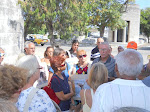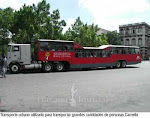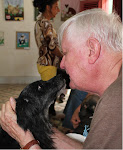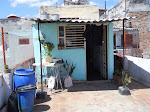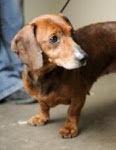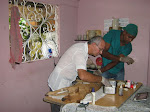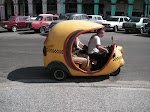One Man’s Meat…
If there are two elements of Cuban society that work well, they are education and health systems. These systems intersect in the University where doctors for people and veterinarians for animals are trained. These professional workers deserve and receive the respect of the man in the street, but they are paid little better than any other workers. So the vets often operate a sideline offering medical care to pet dogs and cats.
A cow or a pig is a unit of production, and therefore it is considered the property of the state. In their regular jobs vets often care for farm animals, but your family’s dog or cat is of no interest to the state, only to his owners. Many of the medicines and supplies used by veterinarians for dogs and cats are scarce or nonexistent in Cuba—especially if they are packaged in the smaller doses made for dogs and cats. Products like flea and tick remedies, dog shampoos, and heartworm medicines are needed in Cuba, although they are abundant here.
In the US many of these meds have expiration dates, and it is illegal to use them after their expiration date. They often sit on a veterinarian’s shelf for months after their expiration dates and are then thrown away. In Cuba drugs have expiration dates too, and those dates are observed for humans, but not for dogs and cats. Sometimes a hospital will even donate outdated drugs to veterinarians.
We have been asking US vets to donate outdated pet meds to us for use in Cuba. We have collected significant quantities for Aniplant in Havana. Cuba allows each visitor to bring in 10 kilograms (22 pounds) of “health products,” and most travelers between Miami and Havana use this allowance to bring in soaps, shampoo, or toothpaste for relatives there. But on our trips we have each been carrying 10 kg of donated outdated vet meds and supplies.
Also notable among Cuban vets is a lack of pill-type medicines. When they have medicines, they are usually in injectable form. The outdated pills we bring in from the US are very welcome as they last longer, are easier to apply, and don’t require the use of sterile syringes.
Nora Garcia, the president of Aniplant, dispenses some vet services from her headquarters on Principe Street in Central Havana. But she knows countless other vets who work in her free weekend spay-neuter clinics. Nothing goes to waste in Cuba, and the extra outdated vet items she doesn’t use herself are traded to local vets for help in the clinics.
Cuban vets have become experts in which medicines last the longest after their expiration. One vet from Old Havana told me he had some old anesthesia drugs from the Cuban campaigns in Angola (in the 1990’s) that still worked.
Waste not, want not.
Les Inglis
Friday, June 25, 2010
Friday, June 18, 2010
Radio Days
Radio Days
A trip to Cuba is like traveling backwards in a time machine. We’ve all seen the old cars still plying the streets of Old Havana and Vedado. But less known, perhaps, is the prominence of radio in the country’s communications. It’s far more patronized and important than television.
Yes, your hotel room in Havana has a TV set, but it is hooked up to satellite receivers unavailable legally to the man in the street. In your hotel room you can even get CNN, but a Havana man depends upon Radio Progreso for most of his news and some of his entertainment. Radio Progreso, owned and operated by the Cuban government presents news, music, talk shows, soap operas, and educational programming. You can listen to it on 630 kilo Hertz in many parts of Florida.
One daily educational show is about farming, and twice a week Nora Garcia presents a program on caring for your dogs and cats. Her shows are popular and heeded by a population that loves their pets but can’t afford veterinarians or prepared dog food.
Nora deals on the radio with timely issues to help pet owners and their animals. For instance, last November we visited Radio Progreso, just around the corner from Havana’s beautiful Hotel Nacional. It was the height of the H1N1 swine flu scare, and a rumor had started that you could catch the deadly flu from your dog or cat. Nora put that rumor to rest in no uncertain terms in her Saturday morning talk. There is no way to measure how many animals were saved from being banished from their homes in a hysterical, rumor-driven wave of fear, but Nora’s voice for the animals is known and respected, and reason prevailed in Cuba as swine flu season passed.
Radio Progreso has a big neon sign (probably straight out of the 1940’s) on its old building, and I had seen it several times before we arranged to watch Nora’s show. On arrival, we had to be admitted by the station manager, who turned out to be a genial host. But, as we entered, we had one more reminder of the old-timey Cuban environment. He apologized, telling us we’d have to use the stairs to the 4th floor studio as the elevator was on the fritz.
It was worth the climb to see another aspect of the tough fight Nora and Aniplant wage to protect animals in Cuba. a fight I’m proud to be a small part of.
Les Inglis
A trip to Cuba is like traveling backwards in a time machine. We’ve all seen the old cars still plying the streets of Old Havana and Vedado. But less known, perhaps, is the prominence of radio in the country’s communications. It’s far more patronized and important than television.
Yes, your hotel room in Havana has a TV set, but it is hooked up to satellite receivers unavailable legally to the man in the street. In your hotel room you can even get CNN, but a Havana man depends upon Radio Progreso for most of his news and some of his entertainment. Radio Progreso, owned and operated by the Cuban government presents news, music, talk shows, soap operas, and educational programming. You can listen to it on 630 kilo Hertz in many parts of Florida.
One daily educational show is about farming, and twice a week Nora Garcia presents a program on caring for your dogs and cats. Her shows are popular and heeded by a population that loves their pets but can’t afford veterinarians or prepared dog food.
Nora deals on the radio with timely issues to help pet owners and their animals. For instance, last November we visited Radio Progreso, just around the corner from Havana’s beautiful Hotel Nacional. It was the height of the H1N1 swine flu scare, and a rumor had started that you could catch the deadly flu from your dog or cat. Nora put that rumor to rest in no uncertain terms in her Saturday morning talk. There is no way to measure how many animals were saved from being banished from their homes in a hysterical, rumor-driven wave of fear, but Nora’s voice for the animals is known and respected, and reason prevailed in Cuba as swine flu season passed.
Radio Progreso has a big neon sign (probably straight out of the 1940’s) on its old building, and I had seen it several times before we arranged to watch Nora’s show. On arrival, we had to be admitted by the station manager, who turned out to be a genial host. But, as we entered, we had one more reminder of the old-timey Cuban environment. He apologized, telling us we’d have to use the stairs to the 4th floor studio as the elevator was on the fritz.
It was worth the climb to see another aspect of the tough fight Nora and Aniplant wage to protect animals in Cuba. a fight I’m proud to be a small part of.
Les Inglis
Friday, June 11, 2010
Making Ends Meet
Making Ends Meet
Cuba fought three wars for independence from Spain, a colonial power. Finally, with the help of the US, it gained independence in 1902. There followed a succession of Presidents, good and bad, with some really being dictators. Fulgencio Batista, who preceded Fidel Castro in power, was a former President who came back to power as a dictator. In the 1950’s he ran a country that had sold out to the American Mafia, and Cuba became a land of casinos, revelry, and mob influence. Many Cubans made a good living in those days, but those days have been gone for a long time in today’s Cuba.
Fidel Castro came to power on January 1, 1959, and he was welcomed by many, but not by the mobsters who ran the casinos. They were soon sent packing and the casinos closed down. Fidel got off to a rocky start that soon left him estranged with Americans (who owned 71% of Cuban businesses). After a series of nationalizations of US owned businesses, Cuba found itself an outcast in the western world. The only supporter Fidel could find was the Soviet Union.
Economically things went from bad to worse as the sugar industry (Cuba’s largest) steeply declined and a US embargo took hold. In a short time, “el comunismo” reigned in the “Pearl of the Antilles,” formerly the greatest colonial prize of Spain’s empire. Bad times prevailed, everyone pretended to work for the government, and the government pretended to pay them with shrinking pesos. Flash forward 50 years of struggle and you find the Cuba of today—where the average wage owner gets perhaps $20.00 a month and small rations of food staples. Nearly everyone cultivates a sideline to earn a little extra. The only exceptions are high political offices and those who run branches of foreign businesses in Cuba.
For Cuban companion animals this tight money problem is worse than it is for the people. Pets get leftovers to eat, or, if they’re lucky, slaughterhouse waste products (even chicken heads) cooked down with rice as a filler. Only the few rich can afford veterinary care unless they are connected with a moonlighting vet who might work evenings in his basement or garage. Yes, even professionals like veterinarians work a sideline for a little extra money. The average vet earns perhaps $250 a year in his government job. Surgery, when needed for dogs and cats is very rare, and the animals are expected to survive as best they can.
Jose, a veterinarian approaching retirement age, practices in Old Havana. To find his office, look in an empty lot walled off from the street with a rusted sheet metal fence. There’s a hole in the sheet metal, and if you duck down you can enter the yard. On one side, a concrete block lean-to like structure with a corrugated iron roof is Jose’s office. Inside are a few chairs, an old stainless steel table, a sterilizer, and a few shelves fixed to the walls. A few bottles of pills are on the shelves, and Jose shows me a cardboard box with vials of injectable meds he has scrounged from hospitals. They’re all out of date, but he rushes to tell me most still work. He even found medicines made for the Cuban campaign in Angola (in the ‘90’s) which still work as anesthesia.
Jose is a skilled vet with a good education (education still works well in Cuba), but with little support for supplies. But local people in his neighborhood love their pets and bring them to the shed to try to help them when they are sick. Jose is a regular at Aniplant’s weekend spay-neuter clinics as well. Cuban animals don’t have much going for them, but at least they have Jose.
Les Inglis
Cuba fought three wars for independence from Spain, a colonial power. Finally, with the help of the US, it gained independence in 1902. There followed a succession of Presidents, good and bad, with some really being dictators. Fulgencio Batista, who preceded Fidel Castro in power, was a former President who came back to power as a dictator. In the 1950’s he ran a country that had sold out to the American Mafia, and Cuba became a land of casinos, revelry, and mob influence. Many Cubans made a good living in those days, but those days have been gone for a long time in today’s Cuba.
Fidel Castro came to power on January 1, 1959, and he was welcomed by many, but not by the mobsters who ran the casinos. They were soon sent packing and the casinos closed down. Fidel got off to a rocky start that soon left him estranged with Americans (who owned 71% of Cuban businesses). After a series of nationalizations of US owned businesses, Cuba found itself an outcast in the western world. The only supporter Fidel could find was the Soviet Union.
Economically things went from bad to worse as the sugar industry (Cuba’s largest) steeply declined and a US embargo took hold. In a short time, “el comunismo” reigned in the “Pearl of the Antilles,” formerly the greatest colonial prize of Spain’s empire. Bad times prevailed, everyone pretended to work for the government, and the government pretended to pay them with shrinking pesos. Flash forward 50 years of struggle and you find the Cuba of today—where the average wage owner gets perhaps $20.00 a month and small rations of food staples. Nearly everyone cultivates a sideline to earn a little extra. The only exceptions are high political offices and those who run branches of foreign businesses in Cuba.
For Cuban companion animals this tight money problem is worse than it is for the people. Pets get leftovers to eat, or, if they’re lucky, slaughterhouse waste products (even chicken heads) cooked down with rice as a filler. Only the few rich can afford veterinary care unless they are connected with a moonlighting vet who might work evenings in his basement or garage. Yes, even professionals like veterinarians work a sideline for a little extra money. The average vet earns perhaps $250 a year in his government job. Surgery, when needed for dogs and cats is very rare, and the animals are expected to survive as best they can.
Jose, a veterinarian approaching retirement age, practices in Old Havana. To find his office, look in an empty lot walled off from the street with a rusted sheet metal fence. There’s a hole in the sheet metal, and if you duck down you can enter the yard. On one side, a concrete block lean-to like structure with a corrugated iron roof is Jose’s office. Inside are a few chairs, an old stainless steel table, a sterilizer, and a few shelves fixed to the walls. A few bottles of pills are on the shelves, and Jose shows me a cardboard box with vials of injectable meds he has scrounged from hospitals. They’re all out of date, but he rushes to tell me most still work. He even found medicines made for the Cuban campaign in Angola (in the ‘90’s) which still work as anesthesia.
Jose is a skilled vet with a good education (education still works well in Cuba), but with little support for supplies. But local people in his neighborhood love their pets and bring them to the shed to try to help them when they are sick. Jose is a regular at Aniplant’s weekend spay-neuter clinics as well. Cuban animals don’t have much going for them, but at least they have Jose.
Les Inglis
Friday, June 4, 2010
Family Walks miles for Their Pet
In Cuba, the government uses prisoners to range through the ciities in trucks to pick up stray dogs. Those poor souls are caged in a facility 15 miles west of Central Havana for 10 days without food but with water. On the 10th day they get a meal laced with strychnine. Adults and puppies, males and females, they lie on the cement cage floors for up to a few hours enduring an indescribable agony. Finally their bodies are relegated to a dump.
This ridding the streets of strays is done in the name of tourism, as the spectacle of straving animals wandering, fighting, or even languishing is bad for tourism, Cuba’s biggest source of hard currency. It doesn’t matter that the zoonosis center where they are killed is staffed with technicians trained to give IV injections—there is no budget for humane injectable drugs. It doesn’t matter the staff hates their work and would love to use IV injections—there’s no budget for anything but strychnine.
And how do the prisoner crews tell owned dogs from strays? Not very well apparently, as Cuban city dwellers usually have no yards, and their dogs are let out into the street to relieve themselves. Collars and tags are rare, and many family pets have been taken away in these stray sweeps. To atone for this, the families are permitted to go to the center and find their pet and take him home during the 10 day impoundment.
On my first trip to Arroyo, the zoonosis center, I remarked on how far it was from the town center as we rode in a cab. I thought it would be hard for a Cuban family to go to Arroyo to look for their pet, since most people don’t have cars. While we talked with the staff, a man, a woman, and a little boy appeared at the entrance at the top of the hill. After a brief conversation at the gate, they were allowed to walk through the long rows of cages until the boy screamed the name of his dog. Yes, against the odds, their long walk had paid off, and they found their dog. A while later, after filling out forms, they started the trek back home, this time leading the dog on a leash.
Nora Garcia, as President of Aniplant, is negotiating with the government to replace the strychnine with injections. If it happens, the change to humane euthanasia will use humane euthanasia medicines furnished by Aniplant, but it will be worthwhile to the 2000 dogs a year being sacrificed to tourism.
Les Inglis
In Cuba, the government uses prisoners to range through the ciities in trucks to pick up stray dogs. Those poor souls are caged in a facility 15 miles west of Central Havana for 10 days without food but with water. On the 10th day they get a meal laced with strychnine. Adults and puppies, males and females, they lie on the cement cage floors for up to a few hours enduring an indescribable agony. Finally their bodies are relegated to a dump.
This ridding the streets of strays is done in the name of tourism, as the spectacle of straving animals wandering, fighting, or even languishing is bad for tourism, Cuba’s biggest source of hard currency. It doesn’t matter that the zoonosis center where they are killed is staffed with technicians trained to give IV injections—there is no budget for humane injectable drugs. It doesn’t matter the staff hates their work and would love to use IV injections—there’s no budget for anything but strychnine.
And how do the prisoner crews tell owned dogs from strays? Not very well apparently, as Cuban city dwellers usually have no yards, and their dogs are let out into the street to relieve themselves. Collars and tags are rare, and many family pets have been taken away in these stray sweeps. To atone for this, the families are permitted to go to the center and find their pet and take him home during the 10 day impoundment.
On my first trip to Arroyo, the zoonosis center, I remarked on how far it was from the town center as we rode in a cab. I thought it would be hard for a Cuban family to go to Arroyo to look for their pet, since most people don’t have cars. While we talked with the staff, a man, a woman, and a little boy appeared at the entrance at the top of the hill. After a brief conversation at the gate, they were allowed to walk through the long rows of cages until the boy screamed the name of his dog. Yes, against the odds, their long walk had paid off, and they found their dog. A while later, after filling out forms, they started the trek back home, this time leading the dog on a leash.
Nora Garcia, as President of Aniplant, is negotiating with the government to replace the strychnine with injections. If it happens, the change to humane euthanasia will use humane euthanasia medicines furnished by Aniplant, but it will be worthwhile to the 2000 dogs a year being sacrificed to tourism.
Les Inglis
Subscribe to:
Posts (Atom)

